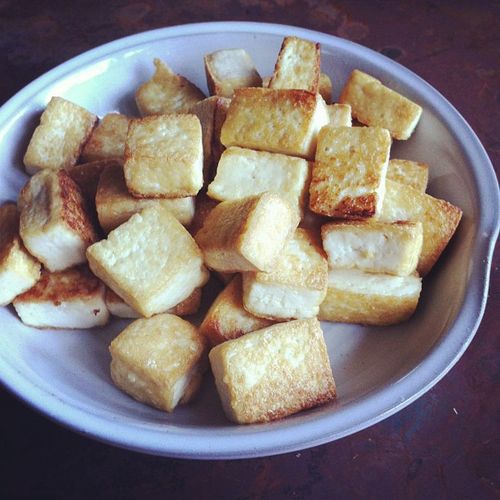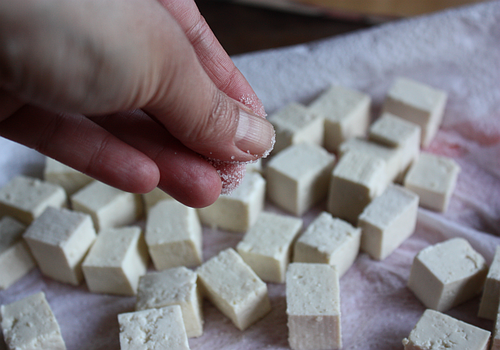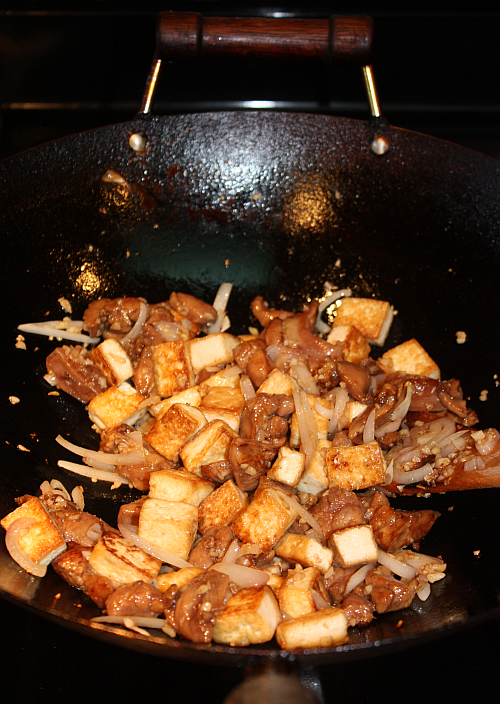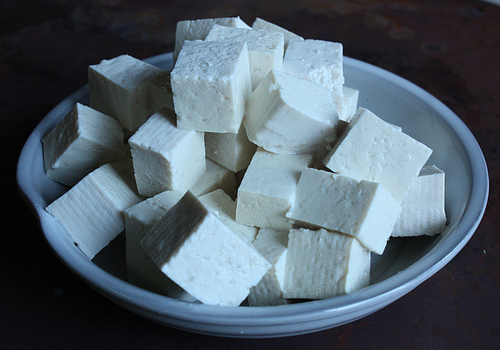I like to eat meat, but just not in large quantities. I’m a
low-meat eater, having grown up in a household where animal protein was never
presented at the table in the form of entire roasts or birds. No Normal
Rockwell images at the holidays. Food was offered in bite size pieces to (1)
make it easier to pick up with chopsticks and (2) feed our family of seven on a
budget. We consumed a lot of vegetables via canh (soups), lettuce and raw
herbs, stir-fries, and noodle dishes. We regularly ate tofu too, usually seasoned with fish sauce
and/or cooked with meat in various Vietnamese preparations. Yes, you can have your meat and eat tofu too!
I didn’t know of vegetarian
tofu scrambles, tofu steaks, and tofu blanketed by cheese sauce until I moved to Santa Cruz,
California, in the late 1990s. A bastion for natural living, there were and
still is a vegetarian restaurant named Dharma’s. At the opposite end of the spectrum
is the Hindquarter Bar and Grille, whose motto is: “where the elite meat.”
I live and eat between those extremes and tofu plays a key
role. If you want to consume less animal protein and/or save money, you don’t
have to forgo meat altogether. Having tofu in your diet is not about
deprivation, or some kind of monk-like existence. Without sacrificing flavor
and with a little help from tofu, you can turn many meat-filled dishes (e.g.,
stews, curries, stir-fries, dumpling filling, meatballs and meatloaf – not roast beef) into
low-meat ones. Here are some ideas:
Don’t go whole hog
by replacing all the animal protein in a recipe with tofu. Keep some real meat
flavor for the tofu to absorb and carry along. Try replacing a third or half of
the meat with tofu. The idea is to extend the natural meat flavor with tofu,
not replace the meat flavor with tofu.

Think of tofu as meat
by choosing a texture like firm or extra firm tofu, which has a certain rich tenderness
(think of it as the tofu equivalent of chicken thigh and pork shoulder) that
allows it to be receptive to the flavor of surrounding ingredients. Super-firm
tofu, which has its practical uses, is super dense like overcooked chicken
breast and pork loin so I prefer to not use it when partially replacing meat in
recipes; it does not quickly absorb flavors because the curds are super compacted.
Use a little more
tofu than the protein you’re replacing because tofu has water. For example,
in a spicy Thai basil chicken recipe, I replaced 8 ounces (240 grams) of
chicken thigh with 10 ounces (300 grams) of tofu. After draining and panfrying,
there was a net amount of tofu that weighed around 8 ounces. (Get the spicy basil chicken and tofu recipe here.)
Prep the tofu an
appropriate size. If you’re replacing some ground meat with tofu, squeeze
the tofu in muslin
to remove some of its water and crush it a bit; finish by mashing with a fork.
For stir-fries and stews, cut the tofu into pieces that best match size of the
meat pieces in the recipe.

Salt and fry tofu
if you’re going to add it to a stir-fry or saucy, stewed dish. We often season meat before cooking it so why not do the same with tofu too? I like to soak tofu in salted water but in a pinch, you can sprinkle salt on pre-cut tofu, just go lightly. Then, either sear,
panfry or deep-fry the tofu to give it texture and extra flavor – more character! Again,
think of what you do with meat when you cook it. Tofu can take a similar kind of treatment.
Add tofu in the
middle or toward the end of the cooking process. Partially or fully cook
the meat before adding the prepped tofu. For the spicy basil chicken and tofu
stir-fry, I added the tofu after the chicken was nearly cooked (the photo at the top of the post) to enable the
tofu to blend with the chicken well. Tofu is an unusual protein because it’s
already “cooked” and ready to eat. Let the animal protein catch up with the
doneness of tofu before adding the tofu!
Imbue tofu with sauce
or liquid seasonings. Tofu has its own delicate umami but it needs to soak
up other flavors to shine. Once tofu is seared, panfried or deep-fried, the pieces
are like a damp sponge with pores that are ready to absorb flavor. Let it sit
in your sauce or allow it to simmer with the liquid seasoning sauce (if needed,
boost the seasonings by a smidgen and add a tablespoon or so of water so there’s something for tofu
to soak).
Give tofu the chance to pick up on the flavors of meat and other
ingredients in your recipe and you won’t regret it.
Got a similar tofu tip
to share? Now is not the time to hold back.
Related posts:



















Maggie says
That's great advice for eating less meat, Andrea. However, I find that Asian dishes tend to contain less of everything, including veg, so I compensate by serving a huge dish of steamed veg (you can steam larger amounts than fry in one go), and a salad to accompany regular stir fries and stews.
Betty says
I love tofu and in Taipei street food stall there one that sold grill tofu stuffed with pickle vegetables in it. Food Network a bar bq tofu grill off for the best grill tofu recipe on this month.
[email protected] says
when we get take-out from our neighborhood chinese restaurant, i always "add tofu" to the entree dishes .. they ask "one dala or two dala?" - i say $2 please, of the silken cubes of tofu .. my husband eats most of the meat, i enjoy most of the tofu .. i'm not a vegetarian but i find myself craving mostly fruit, veg and seafood these days.